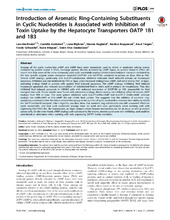| dc.description.abstract | Analogs of the cyclic nucleotides cAMP and cGMP have been extensively used to mimic or modulate cellular events mediated by protein kinase A (PKA), Exchange protein directly activated by cAMP (Epac), or protein kinase G (PKG). We report here that some of the most commonly used cyclic nucleotide analogs inhibit transmembrane transport mediated by the liver specific organic anion transporter peptides OATP1B1 and OATP1B3, unrelated to actions on Epac, PKA or PKG. Several cAMP analogs, particularly with 8-pCPT-substitution, inhibited nodularin (Nod) induced primary rat hepatocyte apoptosis. Inhibition was not mediated by PKA or Epac, since increased endogenous cAMP, and some strong PKA- or Epacactivating analogs failed to protect cells against Nod induced apoptosis. The cAMP analogs inhibiting Nod induced hepatocyte apoptosis also reduced accumulation of radiolabeled Nod or cholic acid in primary rat hepatocytes. They also inhibited Nod induced apoptosis in HEK293 cells with enforced expression of OATP1B1 or 1B3, responsible for Nod transport into cells. Similar results were found with adenosine analogs, disconnecting the inhibitory effect of certain cAMP analogs from PKA or Epac. The most potent inhibitors were 8-pCPT-6-Phe-cAMP and 8-pCPT-29-O-Me-cAMP, whereas analogs like 6-MB-cAMP or 8-Br-cAMP did not inhibit Nod uptake. This suggests that the addition of aromatic ringcontaining substituents like the chloro-phenyl-thio group to the purines of cyclic nucleotides increases their ability to inhibit the OATP-mediated transport. Taken together, our data show that aromatic ring substituents can add unwanted effects to cyclic nucleotides, and that such nucleotide analogs must be used with care, particularly when working with cells expressing OATP1B1/1B3, like hepatocytes, or intact animals where hepatic metabolism can be an issue, as well as certain cancer cells. On the other hand, cAMP analogs with substituents like bromo, monobutyryl were non-inhibitory, and could be considered an alternative when working with cells expressing OATP1 family members. | en_US |

